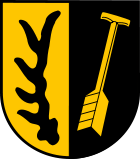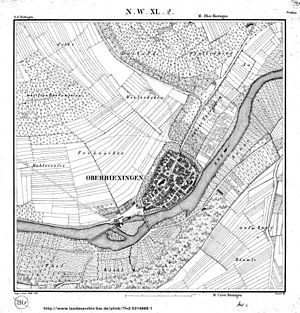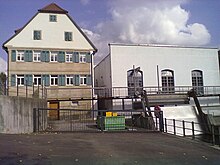Oberriexingen
| coat of arms | Germany map | |
|---|---|---|

|
Coordinates: 48 ° 56 ' N , 9 ° 2' E |
|
| Basic data | ||
| State : | Baden-Württemberg | |
| Administrative region : | Stuttgart | |
| County : | Ludwigsburg | |
| Height : | 203 m above sea level NHN | |
| Area : | 8.16 km 2 | |
| Residents: | 3319 (Dec 31, 2018) | |
| Population density : | 407 inhabitants per km 2 | |
| Postal code : | 71739 | |
| Area code : | 07042 | |
| License plate : | LB, VAI | |
| Community key : | 08 1 18 059 | |
| LOCODE : | DE OXG | |
City administration address : |
Hauptstrasse 14 71739 Oberriexingen |
|
| Website : | ||
| Mayor : | Frank Wittendorfer | |
| Location of the city of Oberriexingen in the Ludwigsburg district | ||
Oberriexingen an der Enz is a small town in the Ludwigsburg district . It belongs to the Stuttgart region (until 1992 the Middle Neckar region ) and the peripheral zone of the European metropolitan region of Stuttgart .
geography

Geographical location
Oberriexingen is located southeast of the Stromberg in the Enz Valley to the left of the river between Vaihingen an der Enz and Markgröningen . At the eastern edge of the municipality, the Dürre Enz flows from the north into the Enz. The district extends from 190 meters on the Enz to 251 meters in the north. Seven Celtic burial mounds and four Roman manors could be identified on the 816 hectare area.
Neighboring communities and desertions
The city borders in the north on Sersheim , in the north-east on the city of Sachsenheim , in the east and south on Unterriexingen (city of Markgröningen ), in the south-west on Enzweihingen (Vaihingen an der Enz) and in the north-west on the city of Vaihingen an der Enz Leinfelder Hof , remnants of the deserted, fallen village of Leinfelden. To the southwest of the village on the opposite side of the Enz valley stood Dauseck Castle , which was in Württemberg hands before 1311 and has long since been lost.
City structure
In addition to the old town, Oberriexingen also includes the semi-circular development areas around it, the Schlossberg house in the south and some resettlers' farms in the north.
Natural monuments and protected landscape areas
In Oberriexingen there are 13 natural monuments (see list of natural monuments in Oberriexingen ). There is also the protected landscape Wolf stables , which is completely on top Riexinger district, as well as the conservation area Enztal between the Leinfelder yard and Bietigheim-Bissingen , which is located partially on top Riexinger municipality.
Division of space

According to data from the State Statistical Office , as of 2014.
history
middle Ages
Riexingen was first mentioned in the Lorsch Codex on April 11, 793. Whether Ober- or Unterriexingen was being addressed could not be clarified without a doubt. The place is first attested as "Obernruxingen" in 1120. In the High Middle Ages it probably belonged to the Lords of Riexingen , who once belonged to the high nobility as noble freemen and who later became vassals of the Württemberg people. According to the Romans, the town, which was temporarily part of the County of Vaihingen, was elevated to a town around 1250. The city's founder is unknown. The first documented mention of a mayor named Gerlach comes from 1281, and it was first named as a town from 1361.
In 1339 the Georgskirche , which was built as a Romanesque fortified church , was mentioned for the first time in the Speyer bishops' registers and around 1439 was given a Gothic choir under the direction of Württemberg . In 1392 at the latest, after the last heiress of the Vaihingen counts died, Oberriexingen came under Württemberg rule and was listed in the Württemberg property register under the former county of Vaihingen in 1420 . The first recorded activity of a Württemberg count in Oberriexingen dates from 1393: Count Eberhard der Milde donated 24 acres of goods and a house in Oberriexingen as a benefice for the Andreas Chapel "uff dem Werd ", which was the provost of the Trinity Monastery in Speyer confirmed. Around 1470 the small town had around 300 inhabitants.
Modern times
On July 13, 1693, French troops looted the small town, which had previously been degraded to the status of official district, and burned down 72 buildings and the church. In the course of the reconstruction, today's town hall was built in 1699.
In 1777 the first passable bridge over the Enz was built. Previously there was only a jetty and a ford downstream. From 1850 the first houses outside the city wall were built; The first industrial settlement took place in 1862, the massive Enz Bridge was built in 1875 and the New School was built in 1896 . Efforts were made in vain for a rail connection. In 1898 the mill was demolished and an electricity station was built instead.
Since the 16th century, the small town, which was delimited for a long time by the medieval city wall, belonged to the Vaihingen district (from 1758 Vaihingen Oberamt ) except for the short period from 1762 to 1769 when it belonged to the Gröningen district . When the new administrative structure was implemented in the Kingdom of Württemberg , which was founded in 1806, Oberriexingen's senior citizenship did not change. In the course of the administrative reform of Württemberg during the Nazi era , the city came to the newly established district of Vaihingen in 1938 .
Contemporary history
During the Second World War , Oberriexingen was spared from bomb hits. On April 8, German troops withdrew to the fortified Neckar-Enz position , which had ran along the opposite Enzhang since 1936, and blew up the Oberriexingen Enz Bridge. On the same day, French troops moved into the undefended town. After the handover, Oberriexingen remained at the front until April 21 and came under German artillery fire several times. Eleven barns were burned down by the French. Quite a few houses had to be evacuated to accommodate soldiers. 30 Nazi party comrades were arrested and some were ill-treated, and some women were raped. Due to the war, the community lost a total of 63 inhabitants and, as a result of the expulsion from the eastern regions, gained 300 inhabitants, predominantly Catholic.
Since the city had become part of the American zone of occupation after the Second World War , it had belonged to the newly founded state of Württemberg-Baden since 1945 , which was merged into the current state of Baden-Württemberg in 1952.
Resistance to the incorporation and the construction of a nuclear power plant
When the district of Vaihingen was dissolved by the execution of the district reform in 1973, Oberriexingen came to the district of Ludwigsburg . The time of community and district reform in Baden-Württemberg was “a time of struggle for independence” in Oberriexingen. Both the union with Unterriexingen , which decided to join Markgröningen, and the incorporation to Sersheim were rejected by the municipal council and citizens' assemblies and this rejection was also enforced. Oberriexingen remained independent, only an administrative partnership with the city of Vaihingen an der Enz was agreed. After that, the community had to assert itself against the planned settlement of a nuclear power plant on their mark. The population rose from 1580 to around 2500 during the 1970s and 1980s; it is now almost 3300.
Religions
Until the introduction of the Reformation in Württemberg the upper Riexinger parish belonged to the Church of St. George and probably 1693 destroyed Andreas chapel on the reflowed from the Enz Worth to Country Chapter Vaihingen in Archidiakonat Trinity of the Diocese of Speyer . The first reformed pastor was Peter Weinöl from 1634 to 1939. From the 16th century until the Second World War, the place was predominantly Protestant. Today there is an Evangelical , an Evangelical Methodist and a New Apostolic congregation in the city. The St. Stephanus congregation in Sersheim is responsible for the spiritual care of the Catholics. It also maintains a church building in Oberriexingen, which was named after the former St. Andreas chapel.
politics
Municipal council
The local council in Oberriexingen has 12 members. The local elections on May 26, 2019 led to the following final result. The municipal council consists of the elected voluntary councilors and the mayor as chairman. The mayor is entitled to vote in the municipal council.
| Parties and constituencies | % 2019 |
Seats 2019 |
% 2014 |
Seats 2014 |
City council election 2019
% 50 40 30th 20th 10
0
40.89%
32.73%
26.38%
UB
OBL
FLF
Gains and losses
compared to
% p 8th 6th 4th 2
0
-2 -4 + 6.36 % p.p.
-2.84 % p.p.
-3.52 % p.p.
UB
OBL
FLF
|
|
|---|---|---|---|---|---|---|
| UB | Independent citizens of Oberriexingen | 40.89 | 5 | 34.53 | 4th | |
| OBL | Oberriexinger Citizen List | 32.73 | 4th | 35.57 | 4th | |
| FLF | Free list women | 26.38 | 3 | 29.90 | 4th | |
| total | 100 | 12 | 100 | 12 | ||
| voter turnout | 68.68% | 54.5% | ||||
mayor
After Oberriexingen was occupied by French troops in April 1945, Mayor Gustav Setzer (in office since 1931) and, after six weeks, his successor Albert Hagstotz, were arrested. First Max Rösch (until August 1946) and then Wilhelm Meeh temporarily took over the post of mayor until Louis Geiger from Upper Swabia was elected mayor in 1948, who held this post until 1969. After a two-year vacancy, Willi Baur was elected in 1971, who remained in office until 2009. In July 2009 Werner Somlai was elected the new mayor with 50.74% of the vote. The current mayor is Frank Wittendorfer, who was elected successor to Werner Somlai with 69.8% in July 2017.
coat of arms
Blazon : “Split between gold and black; in the front a black stag pole set in a pole, behind a golden oar placed on the left. "
The first known seal dates from the early 15th century and already contains the current figures in the undivided shield, but the rudder at the front and with the shovel up. The current arrangement has been documented by David Wolleber since 1591, apart from the color division . In 1605 Johann Siebmacher also showed the shield still undivided and called the rudder "horn". Its inclination is more recent.
flag
The city flag is black and yellow.
Partnerships
Oberriexingen has had a partnership with the Ennery community in France since 1979 .
Culture and sights
theatre
The "Theater Unter der Dauseck Oberriexingen Association", founded in 1993, was named after the former Dauseck Castle . It emerged from the amateur drama group that staged the play “So a Metzelsupp” in 1992 for the 1200th anniversary of Oberriexingen and has since brought a number of other plays to the stage.
museum
In 1958, during construction work, a wine cellar with a well-preserved red grout was discovered and excavated in the foundation walls of a Roman estate. This forms the core of a small museum that was set up by the city and the Württemberg State Museum in 1962 in the basement of a single-family house.
Buildings
The town's landmark is the originally Romanesque St. George's Church , which was rebuilt in the Gothic style in the 14th century , repaired after its destruction (1693) and re-inaugurated in 1707.
Parts of the churchyard and city walls are still preserved, as well as a number of half-timbered houses in addition to the parish and town hall.
Economy and Infrastructure
Fishing and viticulture as well as the milling operations were stopped around 1900. Agriculture, which was once dominant, increasingly lost its importance in the 1960s.
The community has its own public utility, a run-of-river power plant and a sewage treatment plant.
Together with the municipalities of Sachsenheim, Sersheim and Bietigheim-Bissingen , Oberriexingen is part of the association for the inter-municipal Eichwald industrial park on the plateau north of the municipality.
- Education and sport
Oberriexingen has a primary school and two kindergartens , as well as a sports hall and two sports fields.
Personalities
sons and daughters of the town
- Gerd Gaiser (1908–1976), writer
Other personalities associated with the city
- Johann Jacob Heinlin (also: Hainlin) (1588–1660), parish priest in Oberriexingen from 1624 to 1635; from 1654 to 1660 abbot and general superintendent von Bebenhausen and mathematician.
literature
- Karl Eduard Paulus : Description of the Oberamt Vaihingen . Hallberger, Stuttgart 1856. Reprint Bissinger, Magstadt, ISBN 3-7644-0036-6 (The Württemberg Higher Office Descriptions , Vol. 37), Wikisource .
- Hermann Römer : Ortschronik of the municipality Oberriexingen . Markgröningen 1952
- Elsbeth Sieb, Grete Werner-Wesner, Thomas Faltin: Oberriexingen through the ages. The history of the city for the 1200th anniversary. Edited by the city of Oberriexingen. Bietigheim-Bissingen 1992
Individual evidence
- ↑ State Statistical Office Baden-Württemberg - Population by nationality and gender on December 31, 2018 (CSV file) ( help on this ).
- ^ The state of Baden-Württemberg. Official description by district and municipality. Volume III: Stuttgart District, Middle Neckar Regional Association. Kohlhammer, Stuttgart 1978, ISBN 3-17-004758-2 . Pp. 469-470
- ↑ State Statistical Office, area since 1988 according to actual use for Oberriexingen.
- ↑ Source: local dictionary at LeoBW .
- ^ Hermann Römer : Ortschronik of the municipality Oberriexingen . Markgröningen 1952.
- ↑ Elsbeth Sieb, Grete Werner-Wesner a. Thomas Faltin: Oberriexingen through the ages. The history of the city for the 1200th anniversary . Edited by the city of Oberriexingen. Bietigheim-Bissingen 1992, p. 111.
- ↑ Source: local dictionary at LeoBW .
- ↑ Source: HStA Stuttgart, A 602 / WRe No. 14237.
- ↑ Elsbeth Sieb, Grete Werner-Wesner a. Thomas Faltin: Oberriexingen through the ages. The history of the city for the 1200th anniversary . Edited by the city of Oberriexingen. Bietigheim-Bissingen 1992, p. 169.
- ↑ Source: local dictionary at LeoBW .
- ↑ See Württemberg Urflurkarte from 1832, sheet NW 40/2 (layer NW XL, sheet 2).
- ^ Elsbeth Sieb, Grete Werner-Wesner, Thomas Faltin: Oberriexingen in the course of time. The history of the city for the 1200th anniversary. Edited by the city of Oberriexingen. Bietigheim-Bissingen 1992, p. 97 ff.
- ^ Website of the city of Oberriexingen
- ↑ Elsbeth Sieb, Grete Werner-Wesner a. Thomas Faltin: Oberriexingen through the ages. The history of the city for the 1200th anniversary . Edited by the city of Oberriexingen. Bietigheim-Bissingen 1992, p. 169 u. 219.
- ↑ http://www.swp.de/bietigheim/lokales/sachsenheim/buergermeister-somlai-tritt-nicht-mehr-an-14354262.html
- ↑ http://www.oberriexingen.de/stadt-tourismus/aktuelles/aktuelles-aus-oberriexingen/news/02/10/2017/dienstantritt-buergermeister-frank-wittendorfer/
- ↑ Klemens Stadler: German coat of arms. Volume VIII: Baden-Württemberg page 82 . With drawings by Max Reinhart. Angelsachsen-Verlag, Bremen 1971.
- ↑ http://www.ennery95.com/webpages/index.aspx?linkid=2&pageid=2
- ↑ See Reinhard Breymayer : Friedrich Christoph Steinhofer [...]. Heck, Dußlingen 2012, pp. 71–77. 82. 102 (on Heinlin's importance as a mathematics teacher to Princess Antonia of Württemberg and through his preoccupation with the Biblical Summaries for the biblical-summary background of the Kabbalistic teaching table donated by the Princess in Bad Teinach .)








